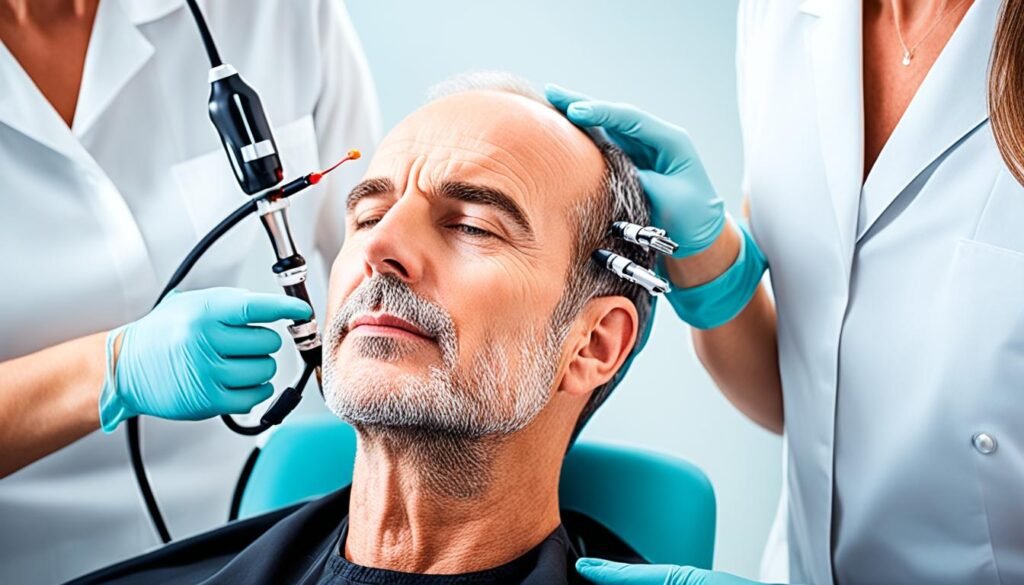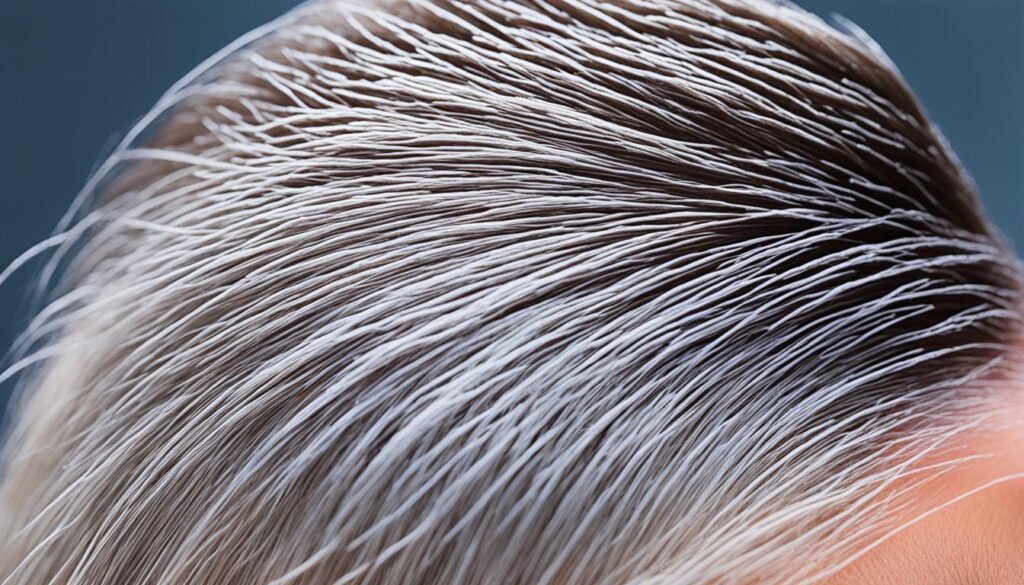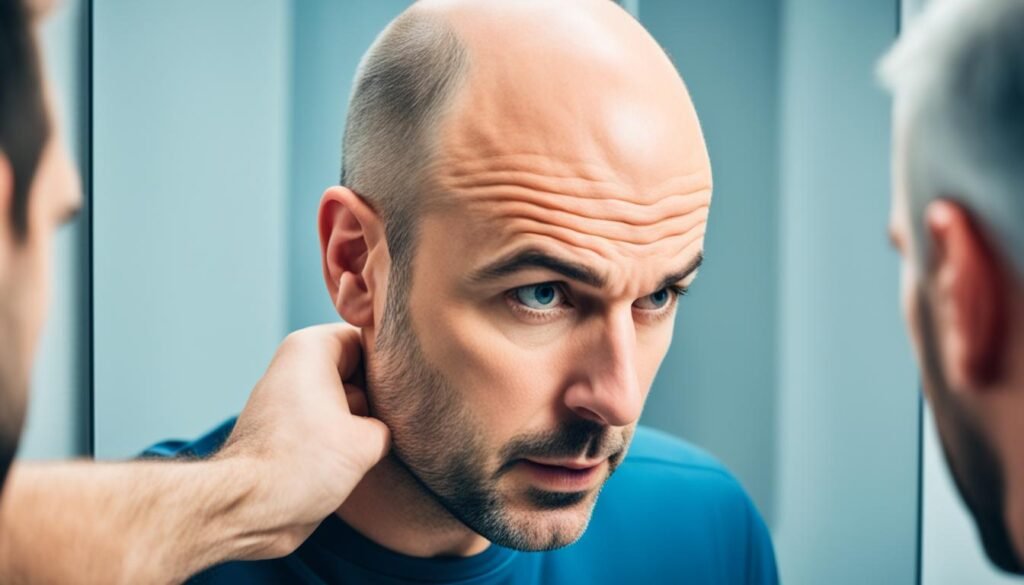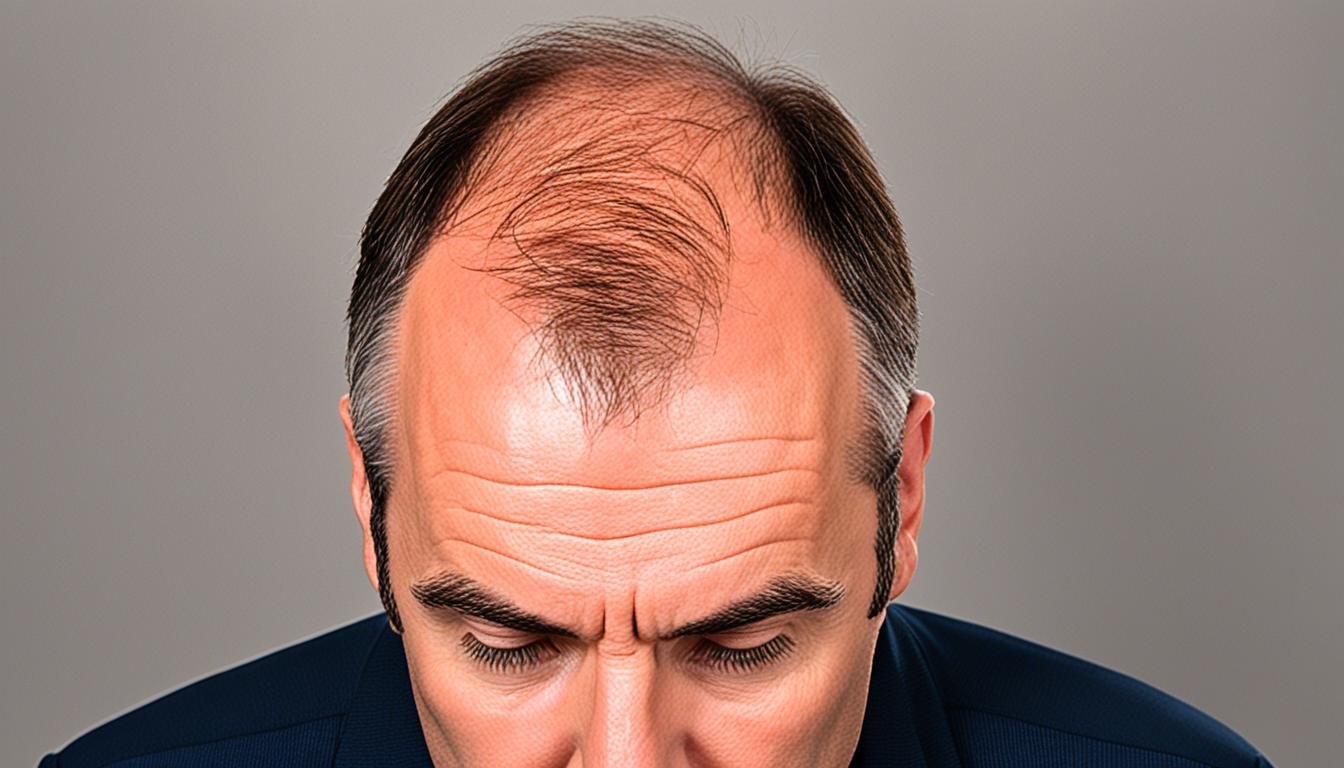Dealing with a receding hairline can be a challenging experience for both men and women. A receding hairline, often associated with male pattern baldness, can significantly impact a person’s self-confidence and overall well-being. However, the good news is that there are effective solutions available to help combat this issue and promote hair regrowth.
In this article, we will explore various receding hairline solutions and share valuable hair growth tips. Whether you are looking for medical treatments or natural remedies, we have got you covered. Our guide will provide you with comprehensive information on the causes of a receding hairline, prevention strategies, and the option of a hair transplant for those seeking long-term solutions.
Key Takeaways:
- Understanding the causes of a receding hairline can help you choose appropriate treatments.
- There are various medical and natural hair loss treatments available to combat a receding hairline.
- Promoting hair growth requires a combination of lifestyle changes, proper nutrition, and the use of hair growth products.
- A hair transplant is a viable option for individuals seeking a permanent solution for their receding hairline.
- Prevention strategies, such as early intervention and scalp care routines, can help maintain a healthy hairline.
Understanding Receding Hairlines and Male Pattern Baldness
Receding hairlines and male pattern baldness are common hair loss concerns that affect many individuals. Understanding the causes and characteristics of these conditions can help individuals make informed decisions about their hair care and treatment options.
Causes of Receding Hairlines:
A receding hairline occurs when hair follicles shrink over time, leading to thinner and shorter hair. While the exact cause can vary, the most common cause is male pattern baldness, also known as androgenetic alopecia.
Male Pattern Baldness:
Male pattern baldness is a genetic condition inherited from either the mother’s or father’s side of the family. It is characterized by a receding hairline that gradually forms an “M” shape and thinning hair on the crown of the head. This condition is caused by the hormone dihydrotestosterone (DHT) and affects approximately 50 million men in the United States.
Distinguishing Male Pattern Baldness from Other Forms of Hair Loss:
Male pattern baldness differs from other forms of hair loss, such as alopecia areata or telogen effluvium, in several ways. Male pattern baldness is typically permanent and progressive, meaning that hair loss worsens over time. It predominantly affects the front and top of the scalp, while other forms of hair loss may cause hair thinning all over the scalp or in circular patches.
| Receding Hairlines | Male Pattern Baldness |
|---|---|
| Gradual hairline regression | Formation of an “M” shape hairline |
| Thinning hair on the temples | Thinning hair on the crown |
| Genetic and hormonal factors | Genetic predisposition and DHT hormone |
| Most common cause of receding hairline | Most common form of hair loss in men |
Hair Loss Treatments for Receding Hairlines
If you’re experiencing a receding hairline, there are several treatment options available to address this concern. These treatments range from medical interventions to natural remedies. Let’s explore the various options:
1. FDA-Approved Medications
One of the most common medical treatments for receding hairlines is the use of FDA-approved medications. These medications work by preventing further hair loss and stimulating hair regrowth. The two main medications prescribed for receding hairlines are:
| Medication | Benefits |
|---|---|
| Finasteride (Propecia) | Blocks the production of DHT, a hormone responsible for hair loss. |
| Minoxidil (Rogaine) | Stimulates hair follicles, promoting hair regrowth. |
It’s important to note that these medications may have different effects on individuals, and their effectiveness can vary. Consulting with a healthcare professional is essential to determine the right medication and dosage for your specific needs.
2. Topical Solutions
In addition to FDA-approved medications, there are also topical solutions available for treating receding hairlines. These solutions are typically applied directly to the scalp and can help improve blood circulation, nurture hair follicles, and promote hair growth. Some popular topical solutions include:
- Hair growth serums
- Essential oils (such as rosemary oil or peppermint oil)
- Scalp massage oils
It’s important to follow the application instructions provided by the manufacturer and consult a healthcare professional if you experience any adverse reactions.
3. Natural Remedies
For those who prefer more natural approaches to hair loss treatment, certain remedies may help slow down the progression of a receding hairline. While natural remedies may not provide drastic results, they can contribute to overall hair health and support hair regrowth. Some natural remedies include:
“Natural remedies can be a complement to other treatment strategies. However, it’s important to consult with a healthcare professional before relying solely on natural remedies for hair loss.”
- Healthy diet rich in vitamins and minerals
- Regular scalp massages
- Herbal supplements (such as saw palmetto or ginseng)
Keep in mind that natural remedies may take longer to show results and their effectiveness may vary from person to person.
Remember, it’s crucial to consult with a healthcare professional or a qualified specialist before starting any hair loss treatment. They can assess your situation, provide personalized recommendations, and help you choose the most suitable solution for your receding hairline.

By exploring these various treatment options, you can take proactive steps towards addressing your receding hairline and promoting hair regrowth.
Promoting Hair Growth: Tips and Techniques
If you’re looking to regrow your receding hairline, there are several practical tips and techniques that can help stimulate hair growth in that area. Whether you’re considering nutritional changes, lifestyle adjustments, or the use of hair growth products, incorporating these strategies into your routine can make a significant difference.
Nutritional Changes
Your diet plays a crucial role in maintaining healthy hair growth. Including certain nutrients can promote hair regrowth and strengthen the hair follicles. Consider incorporating the following foods into your meals:
- Protein-rich foods: Eggs, lean meats, tofu, and legumes are excellent sources of protein, which is essential for hair growth.
- Vitamin C-rich foods: Citrus fruits, berries, and papaya are packed with vitamin C, which aids in collagen production and hair strength.
- Omega-3 fatty acids: Fish like salmon and mackerel, walnuts, and flaxseeds are rich in omega-3 fatty acids, which nourish the hair follicles.
- Zinc-rich foods: Oysters, spinach, and pumpkin seeds contain zinc, a mineral that helps regulate hair growth and repair.
Lifestyle Factors
In addition to nutritional changes, certain lifestyle factors can contribute to hair growth. Consider incorporating these practices into your routine:
- Manage stress: High stress levels can lead to hair loss, so find stress-relieving activities like yoga, meditation, or hobbies that help you relax.
- Avoid excessive heat and styling: Overuse of heating tools and harsh styling products can damage hair follicles, leading to hair loss. Opt for gentle styling techniques and minimize heat exposure.
- Regular scalp massages: Massaging your scalp stimulates blood flow to the hair follicles and promotes hair growth. Use your fingertips and apply gentle pressure.
Hair Growth Products
If you’re looking for additional support, there are various hair growth products available that can aid in regrowing your hairline. Look for products that contain ingredients like minoxidil, biotin, or caffeine, as they have shown effectiveness in promoting hair growth. Always follow the instructions on the product packaging and consult with a healthcare professional if you have any concerns.
Remember, consistency is key when using hair growth products. It may take time to see results, so patience and perseverance are essential.

| Product | Key Ingredients | Benefits |
|---|---|---|
| Nioxin Hair Regrowth Treatment | Minoxidil | Stimulates hair follicles and promotes regrowth |
| Viviscal Hair Growth Supplements | AminoMar complex, biotin, zinc | Nourishes and strengthens existing hair, promotes regrowth |
| Ultrax Labs Hair Surge Shampoo | Caffeine, ketoconazole | Stimulates hair follicles, promotes thickness and fullness |
Hair Transplant for Receding Hairlines
For individuals looking for a more permanent solution to their receding hairline, a hair transplant can be an effective option. This surgical procedure involves transferring hair follicles from a donor site, typically the back or sides of the head, to the areas where hair is thinning or receding.
During the hair transplant procedure, a skilled surgeon carefully extracts individual hair follicles and implants them into small incisions made in the recipient area. Over time, these transplanted hairs will grow naturally, providing fuller coverage and a more youthful hairline.
An important consideration when considering a hair transplant is the suitability of the candidate. Not everyone is an ideal candidate for this procedure, and a thorough consultation with a qualified hair transplant specialist is essential. Factors such as the extent of hair loss, the availability of donor hair, and overall health will be assessed to determine the feasibility and expected results of the transplant.
It is also important to have realistic expectations and understand that a hair transplant is not a quick fix. It takes time for the transplanted hairs to grow and fully blend with the existing hair. Patience is key throughout the recovery process, which may involve initial shedding of the transplanted hairs followed by regrowth.
When choosing a hair transplant provider, it is crucial to research and select a reputable clinic with experienced surgeons. Reading reviews and seeking recommendations from trusted sources can help ensure a successful outcome.
Benefits of Hair Transplant for Receding Hairlines
A hair transplant offers several benefits for individuals with receding hairlines:
- Permanent solution: Unlike temporary hair loss treatments, a hair transplant provides a long-lasting solution by utilizing the individual’s own hair follicles.
- Natural-looking results: The transplanted hair follicles blend seamlessly with the existing hair, creating a natural and undetectable hairline.
- Improved self-confidence: Restoring a receding hairline can significantly boost self-esteem and improve overall confidence.
Before deciding on a hair transplant, it is important to thoroughly discuss the procedure, potential risks, and expected outcomes with a qualified professional. They can provide personalized advice based on the individual’s specific hair loss situation.

| Pros of Hair Transplant | Cons of Hair Transplant |
|---|---|
| Natural and permanent results | Requires a surgical procedure |
| Customizable to individual needs | May involve a recovery period |
| Boosts self-confidence and improves appearance | Potential for scarring or infection |
Prevention Strategies for Receding Hairlines
While dealing with a receding hairline can be disheartening, there are preventative measures you can take to maintain a healthy hairline and minimize further hair loss. By implementing lifestyle changes and adopting a consistent scalp care routine, you can effectively prevent the progression of a receding hairline.
Lifestyle Changes
Making certain adjustments to your lifestyle can significantly impact the health of your hairline. Here are some key lifestyle changes that can aid in preventing receding hairlines:
- Adopting a nutrient-rich diet: Incorporating foods that are high in vitamins, minerals, and proteins can promote optimal hair growth.
- Reducing stress levels: High-stress levels can contribute to hair loss, so practicing stress-management techniques like meditation or yoga can be beneficial.
- Avoiding excessive hairstyling: Overuse of heat styling tools, tight hairstyles, and harsh chemical treatments can weaken hair follicles and lead to hair loss.
- Maintaining a healthy weight: Obesity has been linked to an increased risk of hair loss, so maintaining a healthy weight through proper diet and exercise is important.
Scalp Care Routines
Implementing a consistent scalp care routine can help promote a healthy hairline and prevent hair loss. Here are some scalp care practices to consider:
- Gentle cleansing: Use a mild shampoo and conditioner to keep your scalp clean and free from excess oils and product buildup.
- Regular scalp massages: Massaging your scalp stimulates blood flow to the hair follicles, promoting hair growth.
- Avoiding excessive heat: Limit the use of hot styling tools and avoid exposing your scalp to excessive heat from the sun or hot showers.
- Using hair-friendly accessories: Opt for hair accessories that don’t pull or tug at your hair, as excessive tension can contribute to hair loss.
“By implementing lifestyle changes and adopting a consistent scalp care routine, you can effectively prevent the progression of a receding hairline.”
| Prevention Strategy | Description |
|---|---|
| Adopting a nutrient-rich diet | Consuming foods high in vitamins, minerals, and proteins can provide the necessary nutrients for healthy hair growth. |
| Reducing stress levels | Practicing stress-management techniques can help alleviate hair loss caused by high-stress levels. |
| Avoiding excessive hairstyling | Minimizing the use of heat styling tools, tight hairstyles, and harsh chemicals can prevent damage to hair follicles. |
| Maintaining a healthy weight | Being at a healthy weight reduces the risk of hair loss associated with obesity. |
| Gentle cleansing | Using mild shampoos and conditioners helps maintain scalp health and cleanliness. |
| Regular scalp massages | Massaging the scalp stimulates blood circulation and promotes hair growth. |
| Avoiding excessive heat | Limiting the use of hot styling tools and protecting the scalp from extreme heat helps prevent hair damage and loss. |
| Using hair-friendly accessories | Choosing accessories that minimize tension and pulling helps reduce hair breakage and loss. |
Conclusion
Dealing with a receding hairline can be disheartening, but there are effective solutions available to help restore hair growth and regain confidence. By following the tips and treatments mentioned in this guide, individuals can take control of their receding hairline and work towards maintaining a healthy hairline.
Early intervention is crucial when it comes to addressing a receding hairline. Recognizing the signs and taking action as soon as possible can prevent further hair loss and promote regrowth. Whether it’s making lifestyle changes, using hair growth products, or seeking medical treatments, taking proactive steps can yield positive results.
Consistency is also key. Developing a regular hair care routine and sticking to it can greatly improve the health and appearance of a receding hairline. From nourishing the scalp with proper nutrients to practicing good hair hygiene, maintaining a consistent and dedicated approach is essential for long-term success.
Remember, you’re not alone in this journey. Countless individuals have successfully overcome a receding hairline and regained their confidence. By staying informed about the available solutions and implementing the strategies mentioned in this guide, you can take charge of your receding hairline and embrace a healthier, fuller head of hair.
FAQ
What is a receding hairline?
A receding hairline refers to the gradual loss of hair along the hairline, resulting in the hairline moving higher on the forehead.
What causes a receding hairline?
A receding hairline can be caused by various factors, including genetics, hormonal changes, aging, certain medications, and underlying medical conditions.
Can male pattern baldness cause a receding hairline?
Yes, male pattern baldness, also known as androgenetic alopecia, is a common cause of a receding hairline in men. It is primarily influenced by genetics and hormonal factors.
Are there any effective treatments for a receding hairline?
Yes, there are several treatments available for a receding hairline, including medications like minoxidil and finasteride, hair transplant procedures, and natural remedies such as essential oils and scalp massages.
Can hair growth products help regrow a receding hairline?
Hair growth products, such as shampoos, serums, and supplements, can help stimulate hair growth and improve the appearance of a receding hairline. However, results may vary, and it’s best to consult a dermatologist for personalized recommendations.
What is a hair transplant for a receding hairline?
A hair transplant is a surgical procedure that involves taking hair follicles from a donor area (typically the back of the scalp) and grafting them onto the receding areas of the hairline. This technique allows for permanent hair regrowth.
Are there any prevention strategies for a receding hairline?
While it is not possible to completely prevent a receding hairline, certain strategies can help slow down the process and minimize further hair loss. These include maintaining a healthy lifestyle, avoiding excessive heat and chemical treatments, and managing underlying health conditions.

